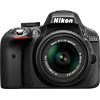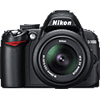Main
Model
Price
Advantages
launch
Announced
Body type
Camera subcategory
Sensor
Effective pixels
Max resolution
Sensor size
Sensor type
Processor
Image ratio w:h
Other resolutions
Sensor photo detectors
Image
ISO
Boosted ISO (maximum)
White balance presets
Custom white balance
Image stabilization
Uncompressed format
JPEG quality levels
Photography features
Minimum shutter speed
Maximum shutter speed
Aperture priority
Shutter priority
Manual exposure mode
Subject / scene modes
Built-in flash
Flash range
External flash
Flash modes
Continuous drive
Self-timer
Metering modes
Exposure compensation
WB Bracketing
Screen / viewfinder
Articulated LCD
Screen size
Screen dots
Touch screen
Screen type
Live view
Viewfinder type
Viewfinder coverage
Viewfinder magnification
Videography features
Resolutions
File Format
Microphone
Speaker
Optics & Focus
Autofocus
Digital zoom
Manual focus
Number of focus points
Lens mount
Focal length multiplier
Physical
Weight (inc. batteries)
Dimensions
Environmentally sealed
Battery
Battery details
Battery Life (CIPA)
Storage
Storage types
Storage included
Connectivity
USB
HDMI
Wireless
Wireless notes
Remote control
Other features
Orientation sensor
Timelapse recording
GPS
GPS notes
Samples
Videos
Summary
The Nikon D3300 maximum resolution of 6000 x 4000 pixels (24 megapixels) is better than the D3000 highest resolution of 3872 x 2592 pixels (10 megapixels). The D3000 is produced with larger sensor than the Nikon D3300: APS-C (23.6 x 15.8 mm) versus APS-C (23.5 x 15.6 mm). This is the most important difference between these models as large sensor lets you to capture photos of the more professional quality. The Nikon D3300 offers a wider ISO range of 100-25600 than 100-1600 ISO range of the D3000. This ISO range allow you to capture better photos in more difficult situations.
The Nikon D3300 display is better as it offers more screen dots 921,000 in comparison to 230,000 dots of the D3000 screen. The higher dot count display is better for reviewing pictures on your camera. The Nikon D3300 supports a very convenient live view function which lets you to use the LCD as a larger viewfinder.
The Nikon D3000 which will help you to transfer photos quick and easy. The Nikon D3300 battery life is better in compare to the D3000 battery life. According to CIPA standards you will be able to produce 700 photos with the D3300 and only 500 with the D3000. The Nikon D3300 weighs 430g that is 106g less than the weight of the Nikon D3000. The Nikon D3300 can utilize optional accessory GPS devices. Recording GPS data can be convenient for the travel photographer, to be able to go into the image metadata and see exactly where an image was captured.
The Nikon D3300 has 14 advantages and the D3000 only 2 so the D3300 will become the best buy. Get the list of the best offers on Amazon.


